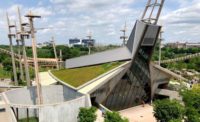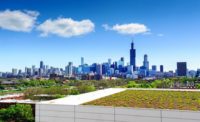Life on Roofs in the United States
ZinCo Green Roofing With System










Green Roofs can be installed on roofs of many different shapes and slopes, but flat roofs lend themselves most readily. Depending on design, a green roof offers new habitat for flora and fauna, in addition to adding convenient and “free” recreational space for people. The higher the urban density, the more valuable and important this space becomes. As a leading pioneer in developing green roof technology, with a 40-year track record, ZinCo stands for permanently reliable green roof systems. Reliability is paired with flexibility. ZinCo has systems suitable for any roof and any design.
Whether it’s a typical flat roof with a slope of 1/24, a zero degree roof, a pitched roof (A-framed, butterfly, shed or saw tooth roof), or even a vaulted barrel roof—a green roof can be installed with slopes up to 8/12. ZinCo will supply the system that is most suited to roof shape, the roof structure and the specific green roof requirements (e.g. biodiversity).
There are two basic types of green roofs: extensive and intensive.
Green at Its Most Diverse
An extensive green roof often covers a large area but it can be installed and maintained at relatively low cost. The typical soil depth for the plants is 2.5 - 6 inches and the weight is low at 20 - 30 pounds per square foot. This allows for the easy greening of an existing roof at a later time. Another advantage of the extensive green roof is the very low upkeep costs as the plants are chosen to survive and grow with natural amounts of precipitation. These plant communities often include various succulents (sedums), mosses, grasses, and herbs. In all cases, the roofs need to be accessed once or twice a year to inspect roof drains and ventilation equipment, in addition to removing unwanted weeds.
Intensive green roofs are very different. This type of green roof makes possible virtually the entire range of landscape architectural ideas. In general what can be done on the ground can be done on the intensive green roof. Plant material including lawn areas, trees and shrubs as well as perennials can be grown in varying depths of soil ranging from 5 – 40 inches. With appropriate structural support, hard landscape elements such as terraces, patios and pathways, as well as play areas, water features and even driveways, are well within the range of design elements used in intensive green roofs. Depending on the design, a weight range of 42 - 260 pounds per square foot should be calculated for intensive green roofs. Irrigation and regular maintenance must also be taken into consideration.
The Appropriate Green Roof System
A green roof system basically consists of a number of layers, each with a different function. The base layer is always a professionally waterproofed roof. The waterproofing must be root-resistant. If not, a separate layer called a root barrier must be installed. The first layer of the actual green roof build-up is a high grade protection sheet which protects the waterproofing from mechanical damage. This is followed by drainage elements that both retain water in their retention cells and drain away surplus water through the channel system molded into the bottom of this layer, carrying it to the roof drains.
Drainage elements will vary depending on the specifics of the roof shape and slope, as well as on the green roof design. The drainage layer is normally installed over the entire green roof area, allowing for free drainage of the entire area even under pathways, terraces and other hard landscape elements. Stone walls, play equipment, and other landscape elements can be built directly on top on this drainage layer. The remainder of the green roof build-up includes a filter fabric installed on top of the drainage layer and finally the growing medium.
The filter fabric prevents fines in the growing medium from migrating into the drainage layer. The growing medium is composed of crushed clay tile or brick and organic materials specifically blended to suit the vegetation that has been planned for the green roof. There are numerous ways to plant the extensive green roof: seed mixtures, sedum cuttings, and small plug plants, and even pre-cultivated vegetation mats, which provide instant cover for the roof. The planting palette for intensive green roofs can include perennials as well as woody plants such as shrubs and trees.
Profitable When Combined with Solar Energy
Green roofs are an obvious partner with solar energy. The synergy effects begin with the use of the green roof to ballast the solar panels eliminating the need to penetrate the waterproofing with mounting brackets. Specially designed base plates that are part of the green roof system secure the brackets which support the solar panels. The second important benefit of the green roof for solar is the increased output from the panels due to a lower ambient temperature on the green roof. This can improve solar performance by approximately 4 percent.
Value Added
Green roofs act as a protective layer on the waterproofing eliminating UV exposure and drastically reducing temperature fluctuations experienced by the waterproofing. This adds up to increasing the longevity of the waterproofing membrane. Green roofs retain rainwater (40 percent - 90 percent depending on the type of green roof), and therefore reduce the storm water—an obvious benefit in highly urbanized areas. Green roofs build-ups enhance the structural sound proofing and also function as additional insulation improving the energy budget (both heating and cooling) of the building.
Green roofs reintroduce greenery into urban areas, which improve air quality and add practical amenity and recreational space at no additional real-estate cost. And finally, green roofs can be beautiful architectural highlights as seen in numerous examples around the world. However, all this is only sustainable if the success of the green roof is guaranteed in the long term with building specific planning, reliable technology, and the professional execution of each project. That is what ZinCo stands for.
Looking for a reprint of this article?
From high-res PDFs to custom plaques, order your copy today!




.png?height=200&t=1740147695&width=200)






